Workplace Communication: Case Study, Communication Models Analysis
VerifiedAdded on 2021/04/17
|15
|3896
|32
Report
AI Summary
This report examines workplace communication, emphasizing its importance for organizational productivity and employee satisfaction. It explores three key communication models: the Shannon and Weaver model, the Interactive communication model, and the Aristotle model. The Shannon and Weaver model highlights the sender, encoder, channel, decoder, and receiver, with noise potentially disrupting the process. The Interactive model emphasizes simultaneous feedback. The Aristotle model focuses on the speaker, speech, audience, and effect. The report applies these models to a case study of a ranch, analyzing how managers and employees use communication to improve operations and customer service. The analysis reveals the strengths and limitations of each model in the context of the case study, highlighting the importance of open communication, feedback, and the adaptation of communication strategies for optimal workplace performance.
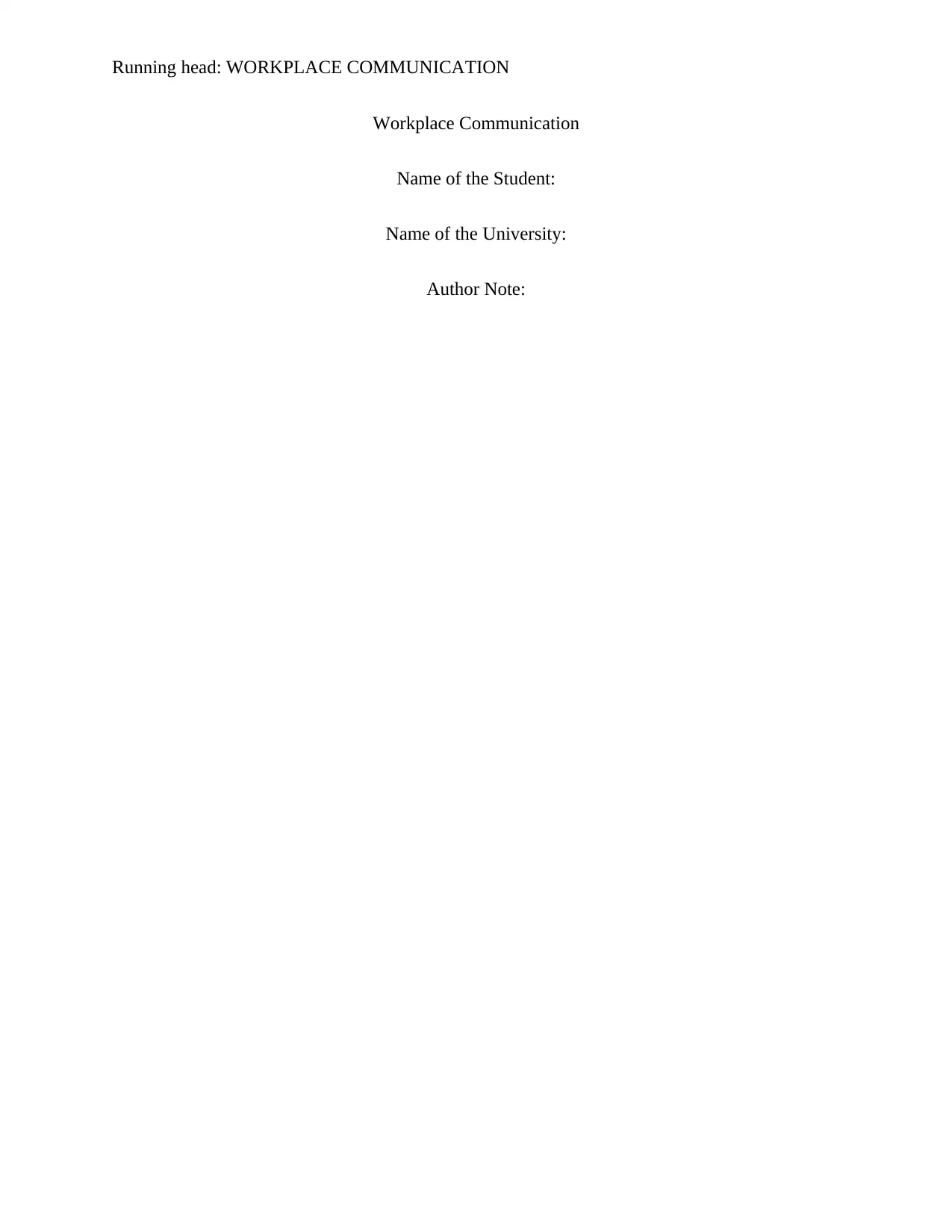
Running head: WORKPLACE COMMUNICATION
Workplace Communication
Name of the Student:
Name of the University:
Author Note:
Workplace Communication
Name of the Student:
Name of the University:
Author Note:
Paraphrase This Document
Need a fresh take? Get an instant paraphrase of this document with our AI Paraphraser
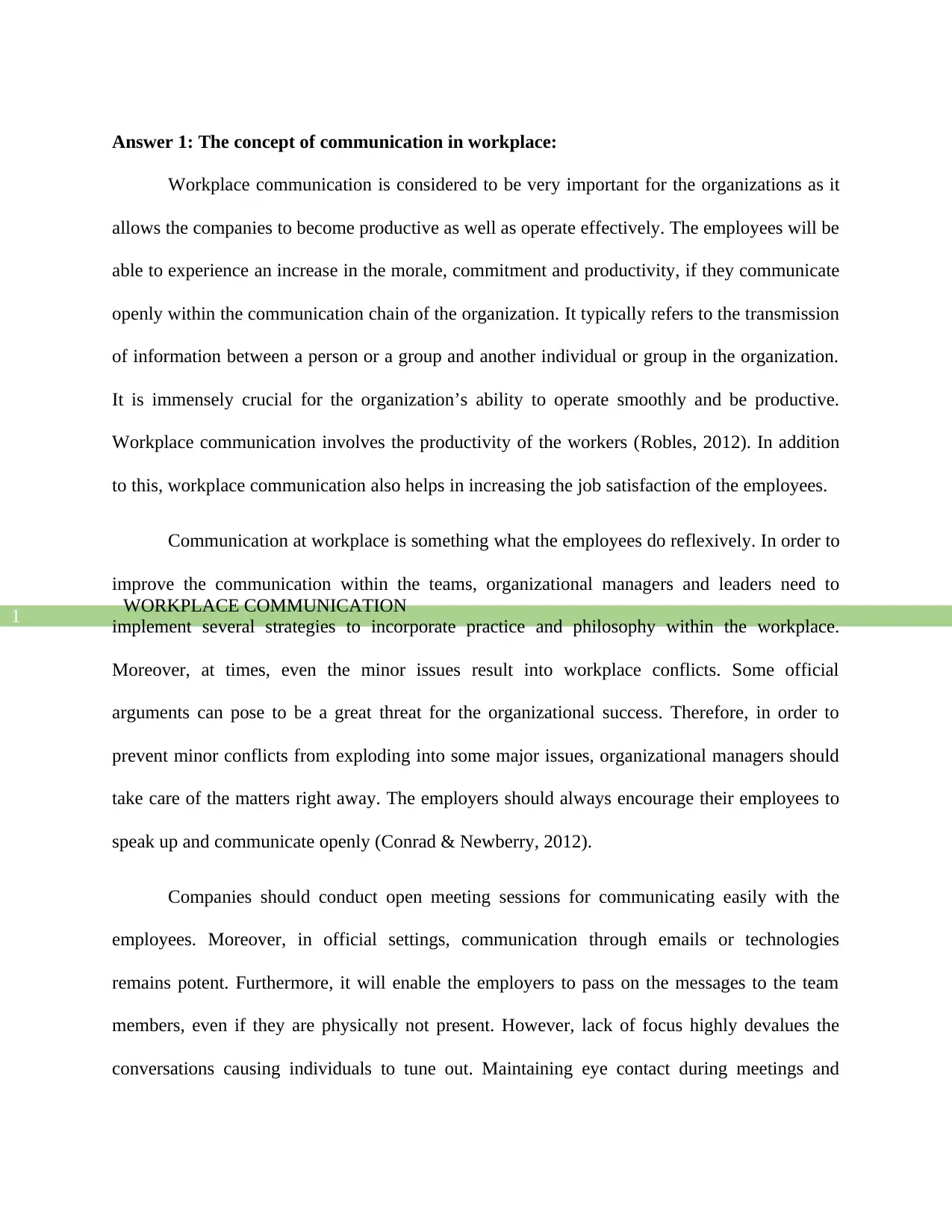
WORKPLACE COMMUNICATION
1
Answer 1: The concept of communication in workplace:
Workplace communication is considered to be very important for the organizations as it
allows the companies to become productive as well as operate effectively. The employees will be
able to experience an increase in the morale, commitment and productivity, if they communicate
openly within the communication chain of the organization. It typically refers to the transmission
of information between a person or a group and another individual or group in the organization.
It is immensely crucial for the organization’s ability to operate smoothly and be productive.
Workplace communication involves the productivity of the workers (Robles, 2012). In addition
to this, workplace communication also helps in increasing the job satisfaction of the employees.
Communication at workplace is something what the employees do reflexively. In order to
improve the communication within the teams, organizational managers and leaders need to
implement several strategies to incorporate practice and philosophy within the workplace.
Moreover, at times, even the minor issues result into workplace conflicts. Some official
arguments can pose to be a great threat for the organizational success. Therefore, in order to
prevent minor conflicts from exploding into some major issues, organizational managers should
take care of the matters right away. The employers should always encourage their employees to
speak up and communicate openly (Conrad & Newberry, 2012).
Companies should conduct open meeting sessions for communicating easily with the
employees. Moreover, in official settings, communication through emails or technologies
remains potent. Furthermore, it will enable the employers to pass on the messages to the team
members, even if they are physically not present. However, lack of focus highly devalues the
conversations causing individuals to tune out. Maintaining eye contact during meetings and
1
Answer 1: The concept of communication in workplace:
Workplace communication is considered to be very important for the organizations as it
allows the companies to become productive as well as operate effectively. The employees will be
able to experience an increase in the morale, commitment and productivity, if they communicate
openly within the communication chain of the organization. It typically refers to the transmission
of information between a person or a group and another individual or group in the organization.
It is immensely crucial for the organization’s ability to operate smoothly and be productive.
Workplace communication involves the productivity of the workers (Robles, 2012). In addition
to this, workplace communication also helps in increasing the job satisfaction of the employees.
Communication at workplace is something what the employees do reflexively. In order to
improve the communication within the teams, organizational managers and leaders need to
implement several strategies to incorporate practice and philosophy within the workplace.
Moreover, at times, even the minor issues result into workplace conflicts. Some official
arguments can pose to be a great threat for the organizational success. Therefore, in order to
prevent minor conflicts from exploding into some major issues, organizational managers should
take care of the matters right away. The employers should always encourage their employees to
speak up and communicate openly (Conrad & Newberry, 2012).
Companies should conduct open meeting sessions for communicating easily with the
employees. Moreover, in official settings, communication through emails or technologies
remains potent. Furthermore, it will enable the employers to pass on the messages to the team
members, even if they are physically not present. However, lack of focus highly devalues the
conversations causing individuals to tune out. Maintaining eye contact during meetings and
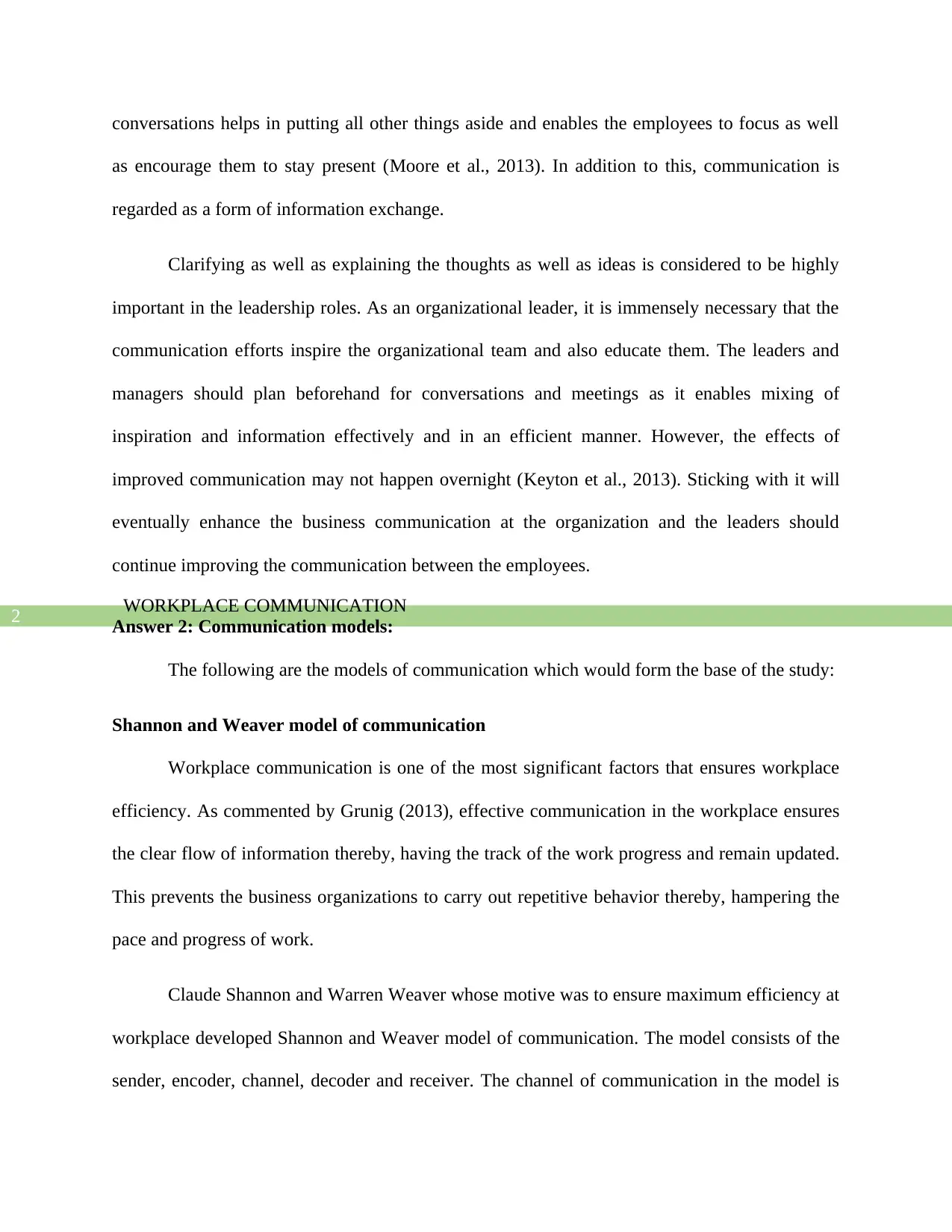
WORKPLACE COMMUNICATION
2
conversations helps in putting all other things aside and enables the employees to focus as well
as encourage them to stay present (Moore et al., 2013). In addition to this, communication is
regarded as a form of information exchange.
Clarifying as well as explaining the thoughts as well as ideas is considered to be highly
important in the leadership roles. As an organizational leader, it is immensely necessary that the
communication efforts inspire the organizational team and also educate them. The leaders and
managers should plan beforehand for conversations and meetings as it enables mixing of
inspiration and information effectively and in an efficient manner. However, the effects of
improved communication may not happen overnight (Keyton et al., 2013). Sticking with it will
eventually enhance the business communication at the organization and the leaders should
continue improving the communication between the employees.
Answer 2: Communication models:
The following are the models of communication which would form the base of the study:
Shannon and Weaver model of communication
Workplace communication is one of the most significant factors that ensures workplace
efficiency. As commented by Grunig (2013), effective communication in the workplace ensures
the clear flow of information thereby, having the track of the work progress and remain updated.
This prevents the business organizations to carry out repetitive behavior thereby, hampering the
pace and progress of work.
Claude Shannon and Warren Weaver whose motive was to ensure maximum efficiency at
workplace developed Shannon and Weaver model of communication. The model consists of the
sender, encoder, channel, decoder and receiver. The channel of communication in the model is
2
conversations helps in putting all other things aside and enables the employees to focus as well
as encourage them to stay present (Moore et al., 2013). In addition to this, communication is
regarded as a form of information exchange.
Clarifying as well as explaining the thoughts as well as ideas is considered to be highly
important in the leadership roles. As an organizational leader, it is immensely necessary that the
communication efforts inspire the organizational team and also educate them. The leaders and
managers should plan beforehand for conversations and meetings as it enables mixing of
inspiration and information effectively and in an efficient manner. However, the effects of
improved communication may not happen overnight (Keyton et al., 2013). Sticking with it will
eventually enhance the business communication at the organization and the leaders should
continue improving the communication between the employees.
Answer 2: Communication models:
The following are the models of communication which would form the base of the study:
Shannon and Weaver model of communication
Workplace communication is one of the most significant factors that ensures workplace
efficiency. As commented by Grunig (2013), effective communication in the workplace ensures
the clear flow of information thereby, having the track of the work progress and remain updated.
This prevents the business organizations to carry out repetitive behavior thereby, hampering the
pace and progress of work.
Claude Shannon and Warren Weaver whose motive was to ensure maximum efficiency at
workplace developed Shannon and Weaver model of communication. The model consists of the
sender, encoder, channel, decoder and receiver. The channel of communication in the model is
⊘ This is a preview!⊘
Do you want full access?
Subscribe today to unlock all pages.

Trusted by 1+ million students worldwide
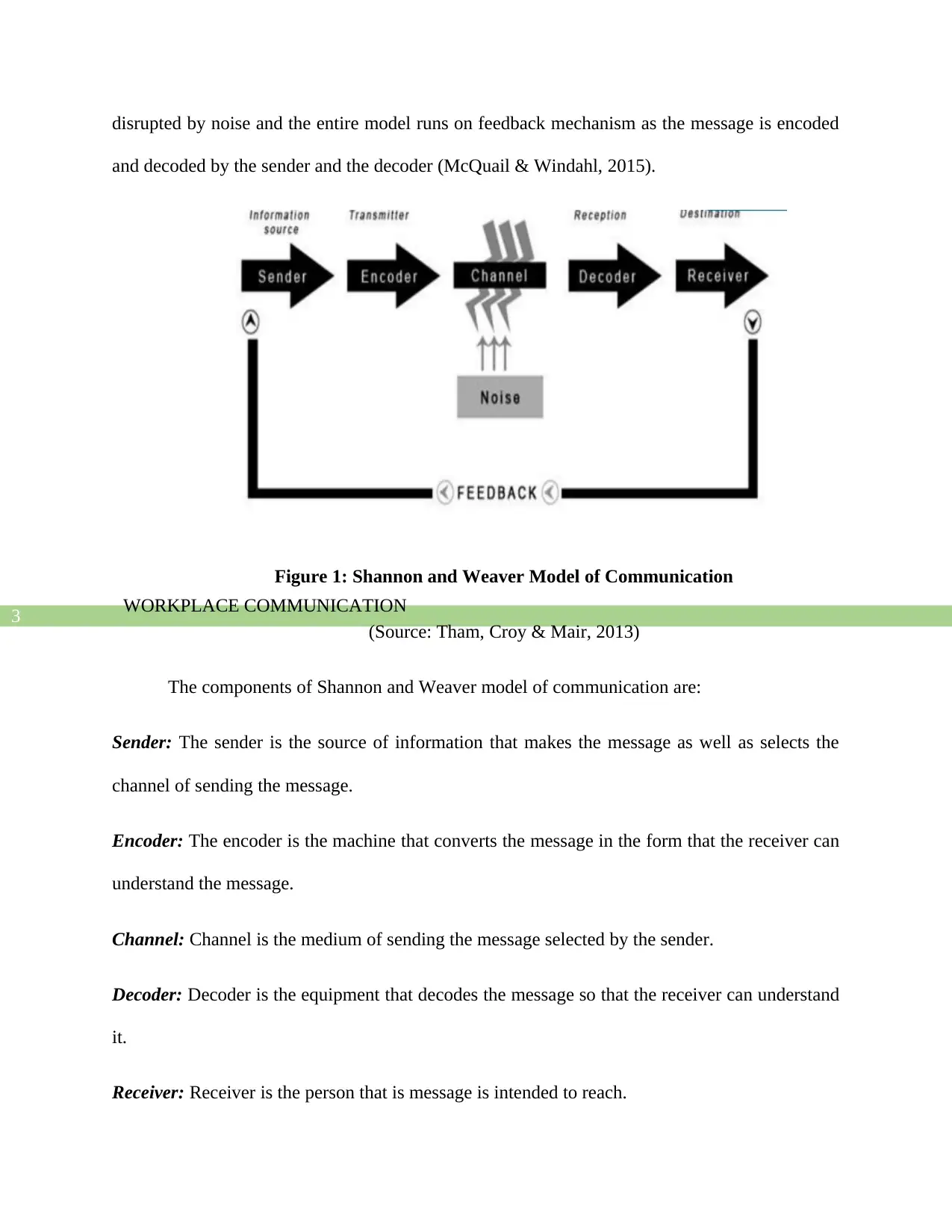
WORKPLACE COMMUNICATION
3
disrupted by noise and the entire model runs on feedback mechanism as the message is encoded
and decoded by the sender and the decoder (McQuail & Windahl, 2015).
Figure 1: Shannon and Weaver Model of Communication
(Source: Tham, Croy & Mair, 2013)
The components of Shannon and Weaver model of communication are:
Sender: The sender is the source of information that makes the message as well as selects the
channel of sending the message.
Encoder: The encoder is the machine that converts the message in the form that the receiver can
understand the message.
Channel: Channel is the medium of sending the message selected by the sender.
Decoder: Decoder is the equipment that decodes the message so that the receiver can understand
it.
Receiver: Receiver is the person that is message is intended to reach.
3
disrupted by noise and the entire model runs on feedback mechanism as the message is encoded
and decoded by the sender and the decoder (McQuail & Windahl, 2015).
Figure 1: Shannon and Weaver Model of Communication
(Source: Tham, Croy & Mair, 2013)
The components of Shannon and Weaver model of communication are:
Sender: The sender is the source of information that makes the message as well as selects the
channel of sending the message.
Encoder: The encoder is the machine that converts the message in the form that the receiver can
understand the message.
Channel: Channel is the medium of sending the message selected by the sender.
Decoder: Decoder is the equipment that decodes the message so that the receiver can understand
it.
Receiver: Receiver is the person that is message is intended to reach.
Paraphrase This Document
Need a fresh take? Get an instant paraphrase of this document with our AI Paraphraser
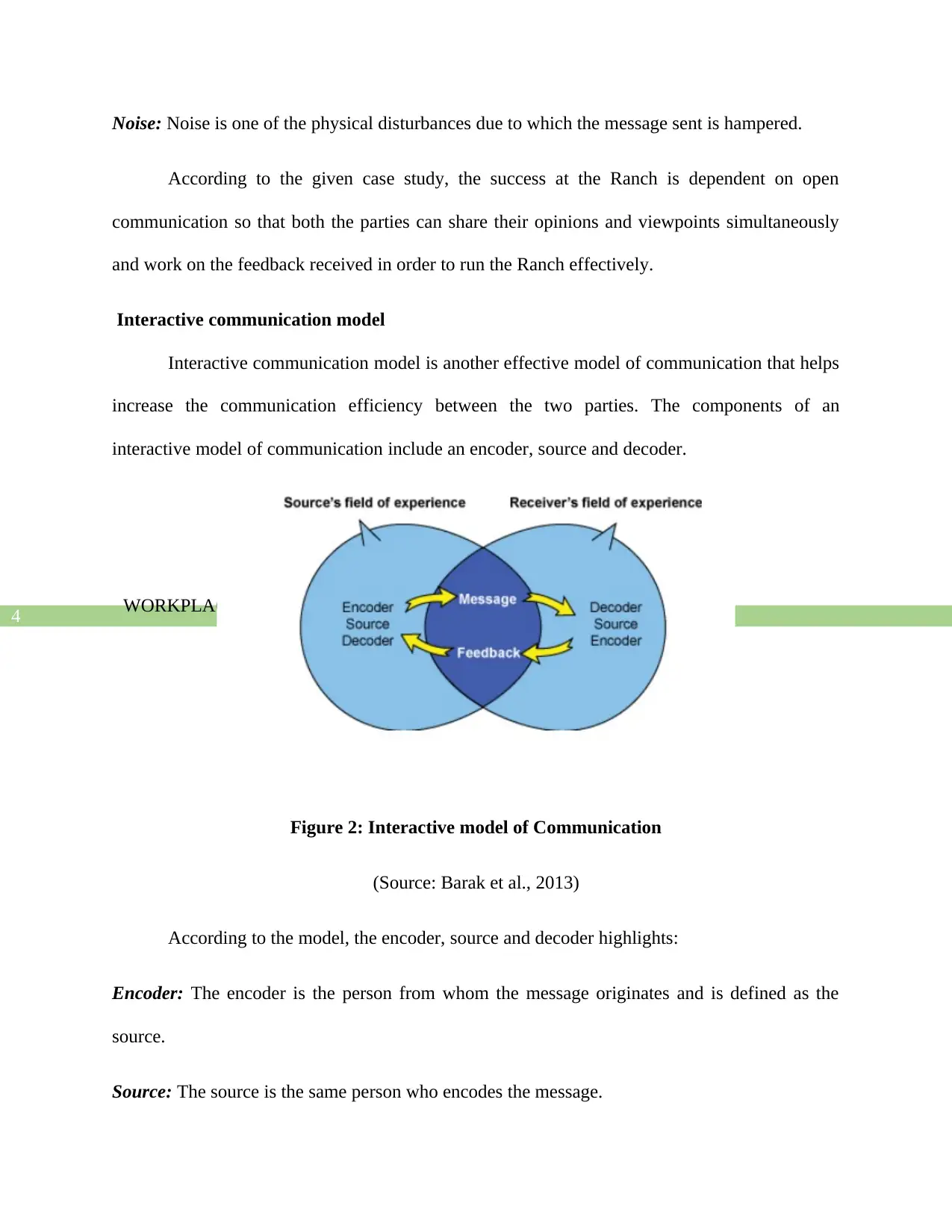
WORKPLACE COMMUNICATION
4
Noise: Noise is one of the physical disturbances due to which the message sent is hampered.
According to the given case study, the success at the Ranch is dependent on open
communication so that both the parties can share their opinions and viewpoints simultaneously
and work on the feedback received in order to run the Ranch effectively.
Interactive communication model
Interactive communication model is another effective model of communication that helps
increase the communication efficiency between the two parties. The components of an
interactive model of communication include an encoder, source and decoder.
Figure 2: Interactive model of Communication
(Source: Barak et al., 2013)
According to the model, the encoder, source and decoder highlights:
Encoder: The encoder is the person from whom the message originates and is defined as the
source.
Source: The source is the same person who encodes the message.
4
Noise: Noise is one of the physical disturbances due to which the message sent is hampered.
According to the given case study, the success at the Ranch is dependent on open
communication so that both the parties can share their opinions and viewpoints simultaneously
and work on the feedback received in order to run the Ranch effectively.
Interactive communication model
Interactive communication model is another effective model of communication that helps
increase the communication efficiency between the two parties. The components of an
interactive model of communication include an encoder, source and decoder.
Figure 2: Interactive model of Communication
(Source: Barak et al., 2013)
According to the model, the encoder, source and decoder highlights:
Encoder: The encoder is the person from whom the message originates and is defined as the
source.
Source: The source is the same person who encodes the message.
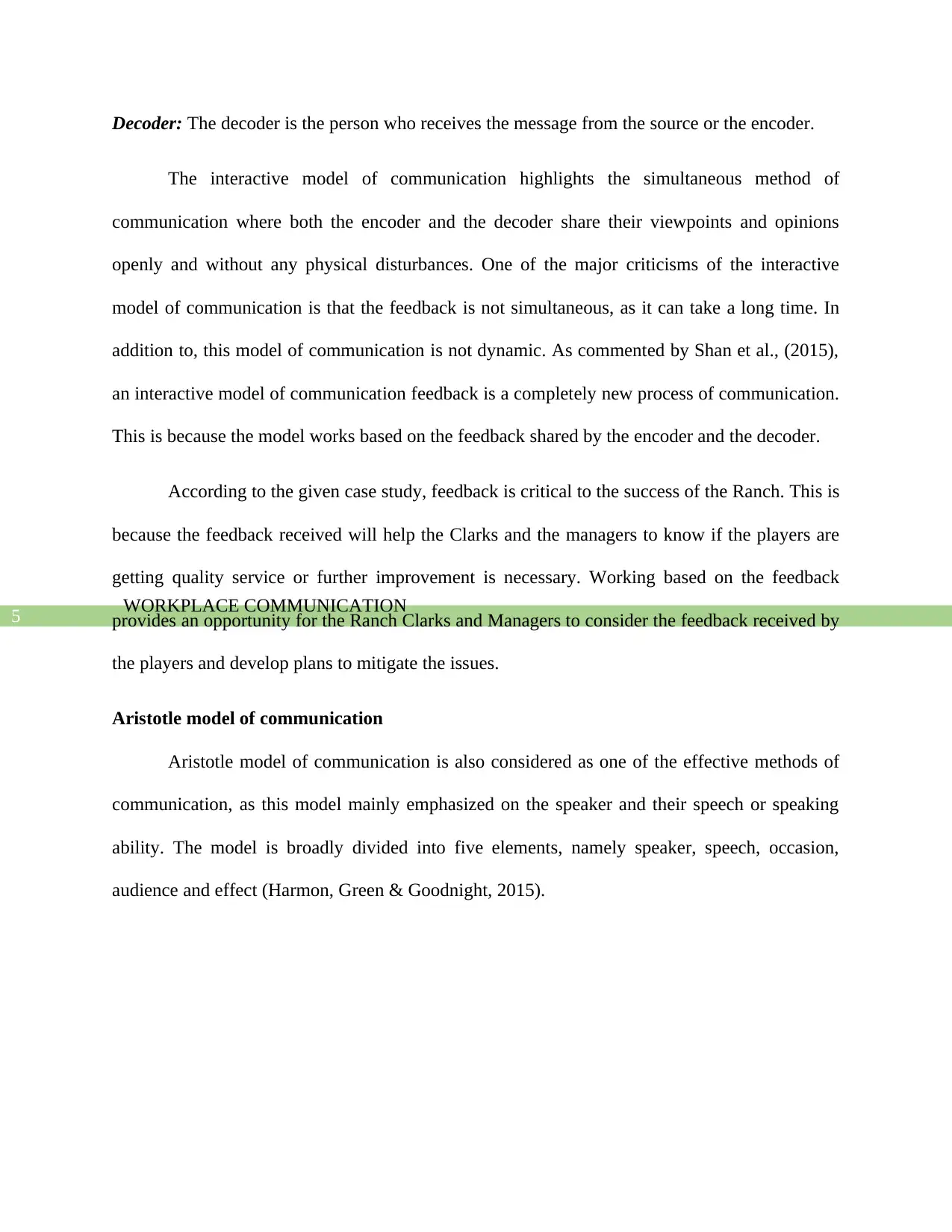
WORKPLACE COMMUNICATION
5
Decoder: The decoder is the person who receives the message from the source or the encoder.
The interactive model of communication highlights the simultaneous method of
communication where both the encoder and the decoder share their viewpoints and opinions
openly and without any physical disturbances. One of the major criticisms of the interactive
model of communication is that the feedback is not simultaneous, as it can take a long time. In
addition to, this model of communication is not dynamic. As commented by Shan et al., (2015),
an interactive model of communication feedback is a completely new process of communication.
This is because the model works based on the feedback shared by the encoder and the decoder.
According to the given case study, feedback is critical to the success of the Ranch. This is
because the feedback received will help the Clarks and the managers to know if the players are
getting quality service or further improvement is necessary. Working based on the feedback
provides an opportunity for the Ranch Clarks and Managers to consider the feedback received by
the players and develop plans to mitigate the issues.
Aristotle model of communication
Aristotle model of communication is also considered as one of the effective methods of
communication, as this model mainly emphasized on the speaker and their speech or speaking
ability. The model is broadly divided into five elements, namely speaker, speech, occasion,
audience and effect (Harmon, Green & Goodnight, 2015).
5
Decoder: The decoder is the person who receives the message from the source or the encoder.
The interactive model of communication highlights the simultaneous method of
communication where both the encoder and the decoder share their viewpoints and opinions
openly and without any physical disturbances. One of the major criticisms of the interactive
model of communication is that the feedback is not simultaneous, as it can take a long time. In
addition to, this model of communication is not dynamic. As commented by Shan et al., (2015),
an interactive model of communication feedback is a completely new process of communication.
This is because the model works based on the feedback shared by the encoder and the decoder.
According to the given case study, feedback is critical to the success of the Ranch. This is
because the feedback received will help the Clarks and the managers to know if the players are
getting quality service or further improvement is necessary. Working based on the feedback
provides an opportunity for the Ranch Clarks and Managers to consider the feedback received by
the players and develop plans to mitigate the issues.
Aristotle model of communication
Aristotle model of communication is also considered as one of the effective methods of
communication, as this model mainly emphasized on the speaker and their speech or speaking
ability. The model is broadly divided into five elements, namely speaker, speech, occasion,
audience and effect (Harmon, Green & Goodnight, 2015).
⊘ This is a preview!⊘
Do you want full access?
Subscribe today to unlock all pages.

Trusted by 1+ million students worldwide
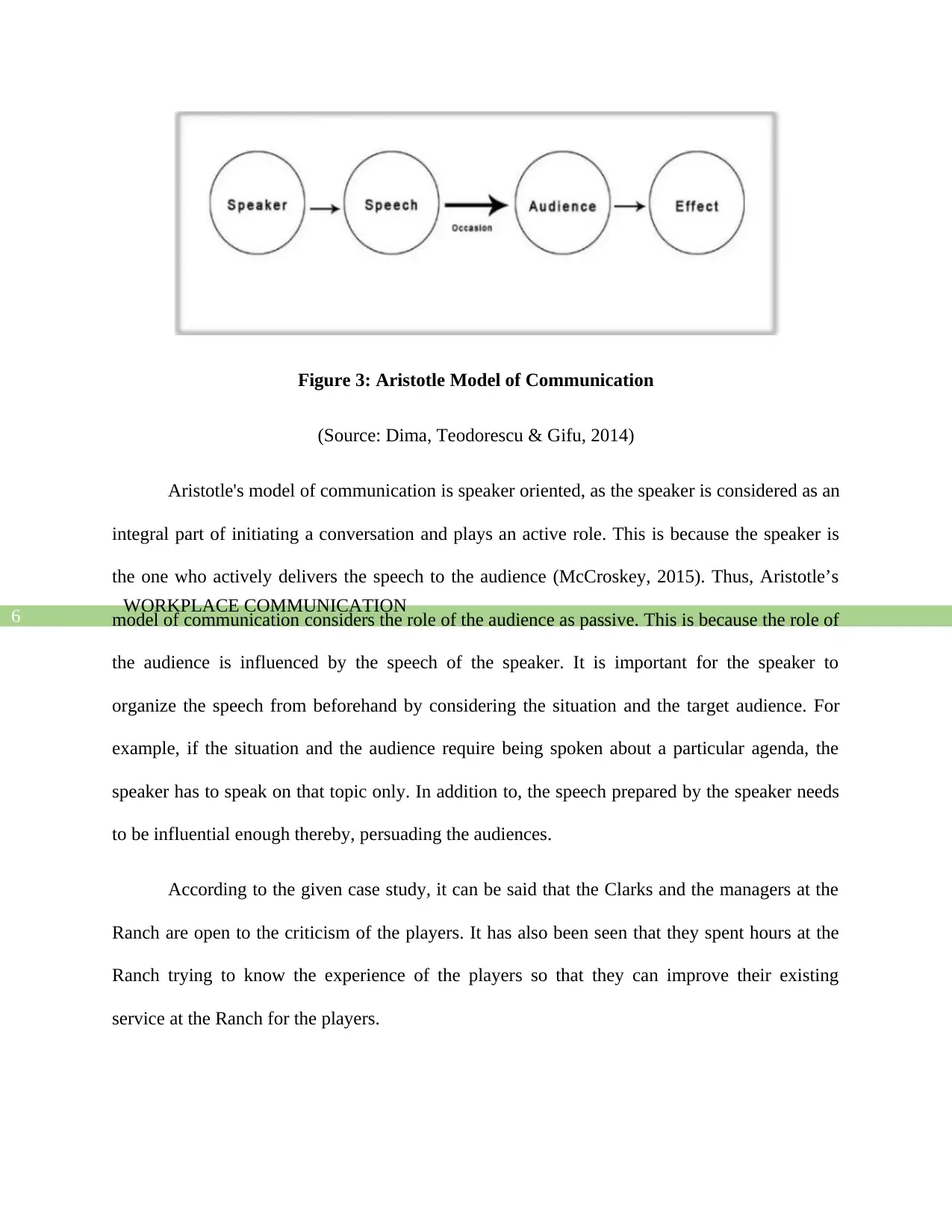
WORKPLACE COMMUNICATION
6
Figure 3: Aristotle Model of Communication
(Source: Dima, Teodorescu & Gifu, 2014)
Aristotle's model of communication is speaker oriented, as the speaker is considered as an
integral part of initiating a conversation and plays an active role. This is because the speaker is
the one who actively delivers the speech to the audience (McCroskey, 2015). Thus, Aristotle’s
model of communication considers the role of the audience as passive. This is because the role of
the audience is influenced by the speech of the speaker. It is important for the speaker to
organize the speech from beforehand by considering the situation and the target audience. For
example, if the situation and the audience require being spoken about a particular agenda, the
speaker has to speak on that topic only. In addition to, the speech prepared by the speaker needs
to be influential enough thereby, persuading the audiences.
According to the given case study, it can be said that the Clarks and the managers at the
Ranch are open to the criticism of the players. It has also been seen that they spent hours at the
Ranch trying to know the experience of the players so that they can improve their existing
service at the Ranch for the players.
6
Figure 3: Aristotle Model of Communication
(Source: Dima, Teodorescu & Gifu, 2014)
Aristotle's model of communication is speaker oriented, as the speaker is considered as an
integral part of initiating a conversation and plays an active role. This is because the speaker is
the one who actively delivers the speech to the audience (McCroskey, 2015). Thus, Aristotle’s
model of communication considers the role of the audience as passive. This is because the role of
the audience is influenced by the speech of the speaker. It is important for the speaker to
organize the speech from beforehand by considering the situation and the target audience. For
example, if the situation and the audience require being spoken about a particular agenda, the
speaker has to speak on that topic only. In addition to, the speech prepared by the speaker needs
to be influential enough thereby, persuading the audiences.
According to the given case study, it can be said that the Clarks and the managers at the
Ranch are open to the criticism of the players. It has also been seen that they spent hours at the
Ranch trying to know the experience of the players so that they can improve their existing
service at the Ranch for the players.
Paraphrase This Document
Need a fresh take? Get an instant paraphrase of this document with our AI Paraphraser
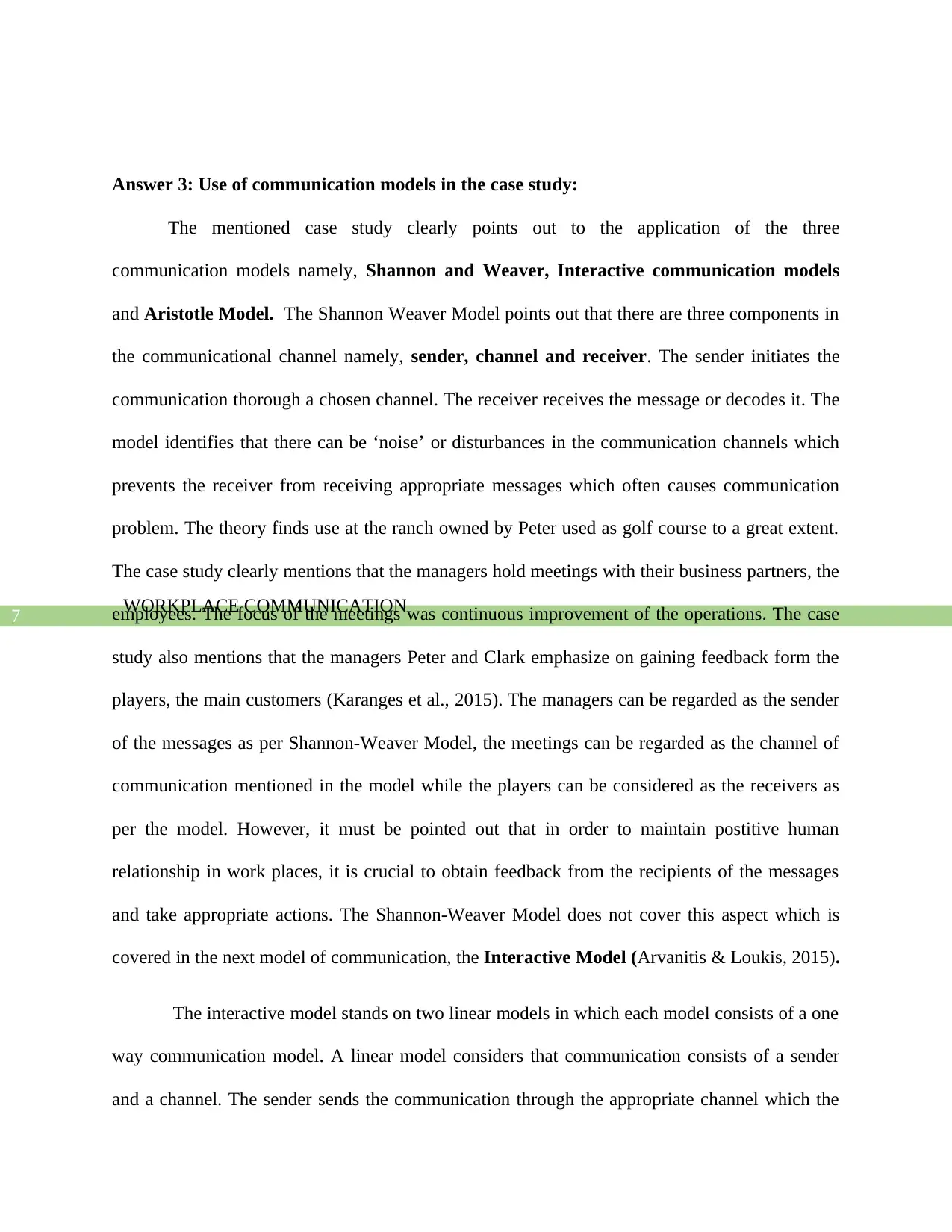
WORKPLACE COMMUNICATION
7
Answer 3: Use of communication models in the case study:
The mentioned case study clearly points out to the application of the three
communication models namely, Shannon and Weaver, Interactive communication models
and Aristotle Model. The Shannon Weaver Model points out that there are three components in
the communicational channel namely, sender, channel and receiver. The sender initiates the
communication thorough a chosen channel. The receiver receives the message or decodes it. The
model identifies that there can be ‘noise’ or disturbances in the communication channels which
prevents the receiver from receiving appropriate messages which often causes communication
problem. The theory finds use at the ranch owned by Peter used as golf course to a great extent.
The case study clearly mentions that the managers hold meetings with their business partners, the
employees. The focus of the meetings was continuous improvement of the operations. The case
study also mentions that the managers Peter and Clark emphasize on gaining feedback form the
players, the main customers (Karanges et al., 2015). The managers can be regarded as the sender
of the messages as per Shannon-Weaver Model, the meetings can be regarded as the channel of
communication mentioned in the model while the players can be considered as the receivers as
per the model. However, it must be pointed out that in order to maintain postitive human
relationship in work places, it is crucial to obtain feedback from the recipients of the messages
and take appropriate actions. The Shannon-Weaver Model does not cover this aspect which is
covered in the next model of communication, the Interactive Model (Arvanitis & Loukis, 2015).
The interactive model stands on two linear models in which each model consists of a one
way communication model. A linear model considers that communication consists of a sender
and a channel. The sender sends the communication through the appropriate channel which the
7
Answer 3: Use of communication models in the case study:
The mentioned case study clearly points out to the application of the three
communication models namely, Shannon and Weaver, Interactive communication models
and Aristotle Model. The Shannon Weaver Model points out that there are three components in
the communicational channel namely, sender, channel and receiver. The sender initiates the
communication thorough a chosen channel. The receiver receives the message or decodes it. The
model identifies that there can be ‘noise’ or disturbances in the communication channels which
prevents the receiver from receiving appropriate messages which often causes communication
problem. The theory finds use at the ranch owned by Peter used as golf course to a great extent.
The case study clearly mentions that the managers hold meetings with their business partners, the
employees. The focus of the meetings was continuous improvement of the operations. The case
study also mentions that the managers Peter and Clark emphasize on gaining feedback form the
players, the main customers (Karanges et al., 2015). The managers can be regarded as the sender
of the messages as per Shannon-Weaver Model, the meetings can be regarded as the channel of
communication mentioned in the model while the players can be considered as the receivers as
per the model. However, it must be pointed out that in order to maintain postitive human
relationship in work places, it is crucial to obtain feedback from the recipients of the messages
and take appropriate actions. The Shannon-Weaver Model does not cover this aspect which is
covered in the next model of communication, the Interactive Model (Arvanitis & Loukis, 2015).
The interactive model stands on two linear models in which each model consists of a one
way communication model. A linear model considers that communication consists of a sender
and a channel. The sender sends the communication through the appropriate channel which the
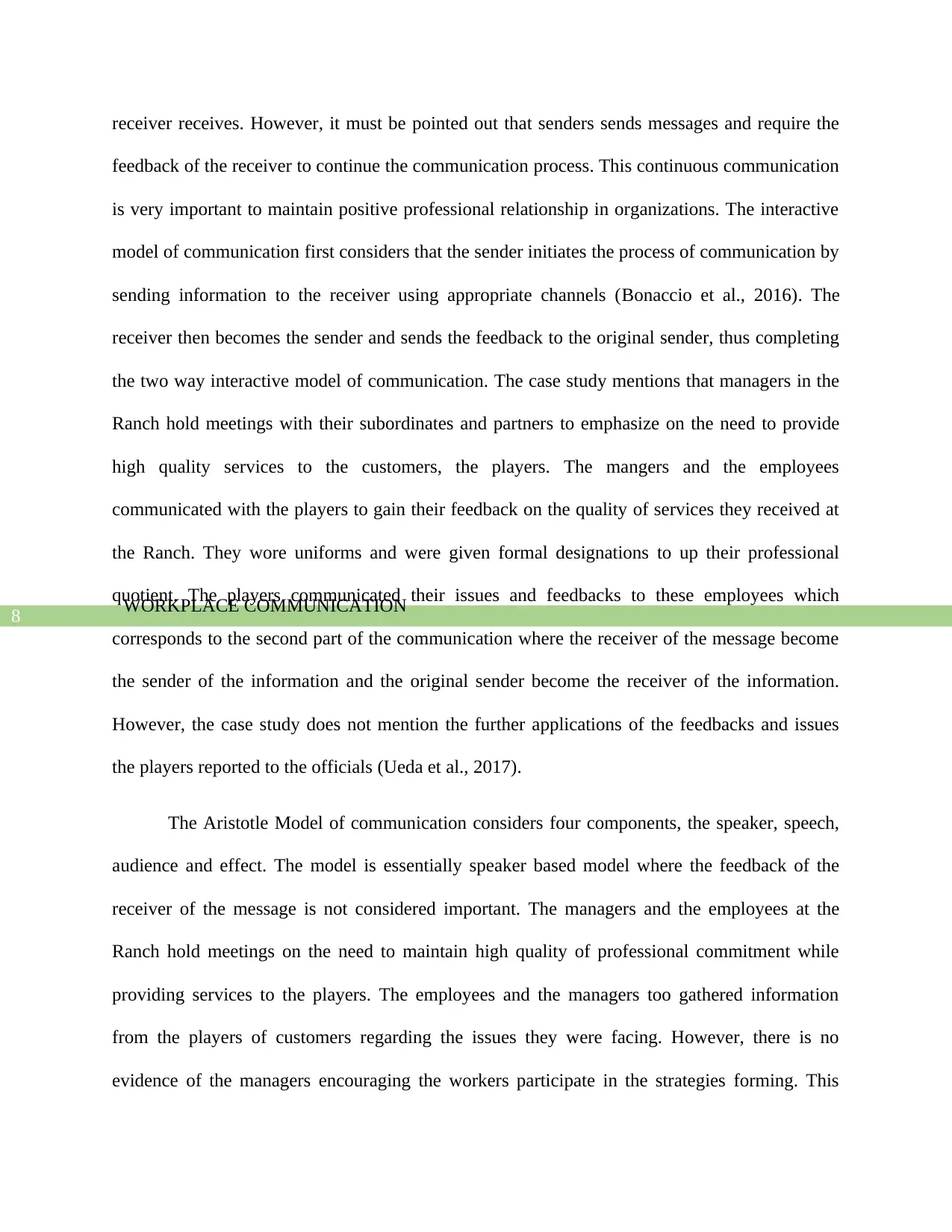
WORKPLACE COMMUNICATION
8
receiver receives. However, it must be pointed out that senders sends messages and require the
feedback of the receiver to continue the communication process. This continuous communication
is very important to maintain positive professional relationship in organizations. The interactive
model of communication first considers that the sender initiates the process of communication by
sending information to the receiver using appropriate channels (Bonaccio et al., 2016). The
receiver then becomes the sender and sends the feedback to the original sender, thus completing
the two way interactive model of communication. The case study mentions that managers in the
Ranch hold meetings with their subordinates and partners to emphasize on the need to provide
high quality services to the customers, the players. The mangers and the employees
communicated with the players to gain their feedback on the quality of services they received at
the Ranch. They wore uniforms and were given formal designations to up their professional
quotient. The players communicated their issues and feedbacks to these employees which
corresponds to the second part of the communication where the receiver of the message become
the sender of the information and the original sender become the receiver of the information.
However, the case study does not mention the further applications of the feedbacks and issues
the players reported to the officials (Ueda et al., 2017).
The Aristotle Model of communication considers four components, the speaker, speech,
audience and effect. The model is essentially speaker based model where the feedback of the
receiver of the message is not considered important. The managers and the employees at the
Ranch hold meetings on the need to maintain high quality of professional commitment while
providing services to the players. The employees and the managers too gathered information
from the players of customers regarding the issues they were facing. However, there is no
evidence of the managers encouraging the workers participate in the strategies forming. This
8
receiver receives. However, it must be pointed out that senders sends messages and require the
feedback of the receiver to continue the communication process. This continuous communication
is very important to maintain positive professional relationship in organizations. The interactive
model of communication first considers that the sender initiates the process of communication by
sending information to the receiver using appropriate channels (Bonaccio et al., 2016). The
receiver then becomes the sender and sends the feedback to the original sender, thus completing
the two way interactive model of communication. The case study mentions that managers in the
Ranch hold meetings with their subordinates and partners to emphasize on the need to provide
high quality services to the customers, the players. The mangers and the employees
communicated with the players to gain their feedback on the quality of services they received at
the Ranch. They wore uniforms and were given formal designations to up their professional
quotient. The players communicated their issues and feedbacks to these employees which
corresponds to the second part of the communication where the receiver of the message become
the sender of the information and the original sender become the receiver of the information.
However, the case study does not mention the further applications of the feedbacks and issues
the players reported to the officials (Ueda et al., 2017).
The Aristotle Model of communication considers four components, the speaker, speech,
audience and effect. The model is essentially speaker based model where the feedback of the
receiver of the message is not considered important. The managers and the employees at the
Ranch hold meetings on the need to maintain high quality of professional commitment while
providing services to the players. The employees and the managers too gathered information
from the players of customers regarding the issues they were facing. However, there is no
evidence of the managers encouraging the workers participate in the strategies forming. This
⊘ This is a preview!⊘
Do you want full access?
Subscribe today to unlock all pages.

Trusted by 1+ million students worldwide
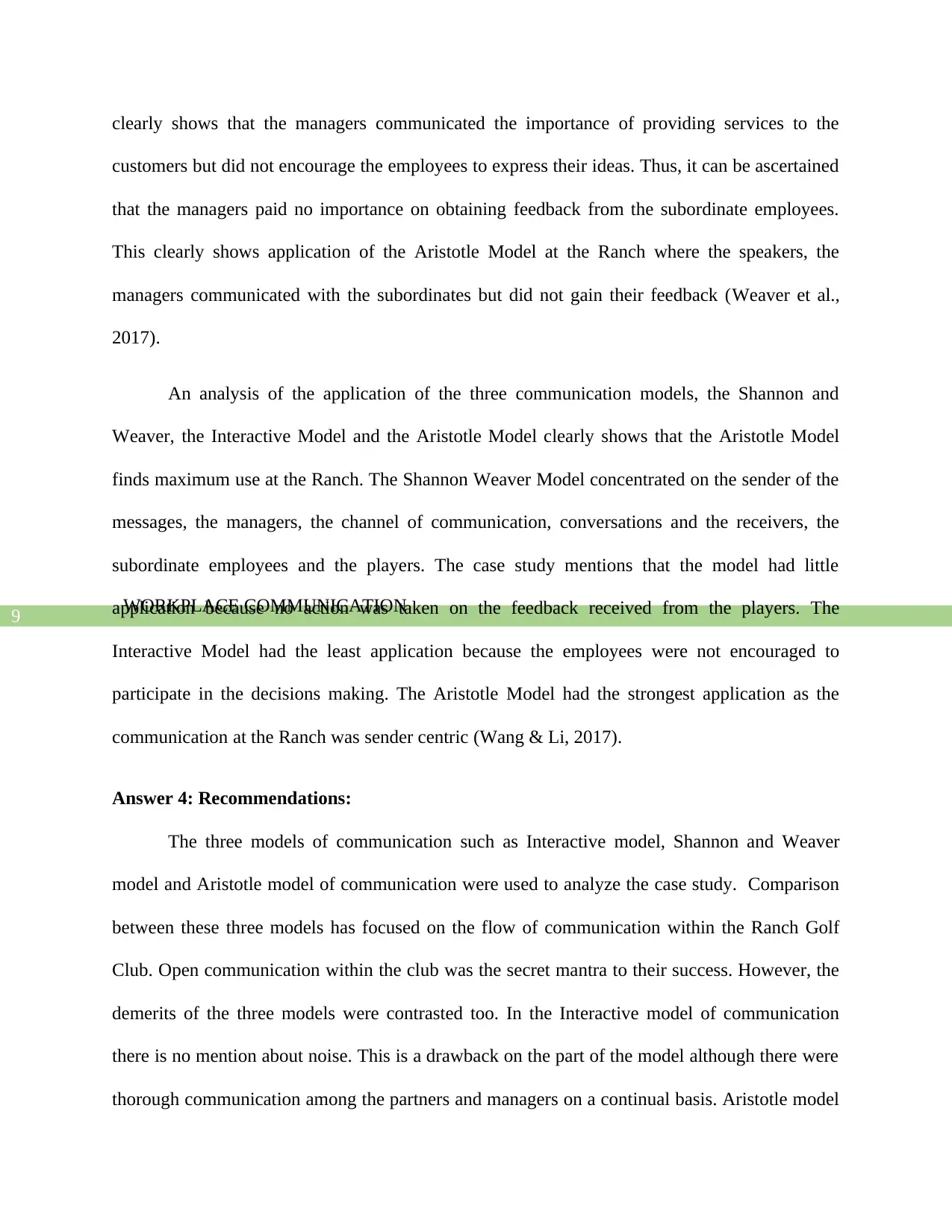
WORKPLACE COMMUNICATION
9
clearly shows that the managers communicated the importance of providing services to the
customers but did not encourage the employees to express their ideas. Thus, it can be ascertained
that the managers paid no importance on obtaining feedback from the subordinate employees.
This clearly shows application of the Aristotle Model at the Ranch where the speakers, the
managers communicated with the subordinates but did not gain their feedback (Weaver et al.,
2017).
An analysis of the application of the three communication models, the Shannon and
Weaver, the Interactive Model and the Aristotle Model clearly shows that the Aristotle Model
finds maximum use at the Ranch. The Shannon Weaver Model concentrated on the sender of the
messages, the managers, the channel of communication, conversations and the receivers, the
subordinate employees and the players. The case study mentions that the model had little
application because no action was taken on the feedback received from the players. The
Interactive Model had the least application because the employees were not encouraged to
participate in the decisions making. The Aristotle Model had the strongest application as the
communication at the Ranch was sender centric (Wang & Li, 2017).
Answer 4: Recommendations:
The three models of communication such as Interactive model, Shannon and Weaver
model and Aristotle model of communication were used to analyze the case study. Comparison
between these three models has focused on the flow of communication within the Ranch Golf
Club. Open communication within the club was the secret mantra to their success. However, the
demerits of the three models were contrasted too. In the Interactive model of communication
there is no mention about noise. This is a drawback on the part of the model although there were
thorough communication among the partners and managers on a continual basis. Aristotle model
9
clearly shows that the managers communicated the importance of providing services to the
customers but did not encourage the employees to express their ideas. Thus, it can be ascertained
that the managers paid no importance on obtaining feedback from the subordinate employees.
This clearly shows application of the Aristotle Model at the Ranch where the speakers, the
managers communicated with the subordinates but did not gain their feedback (Weaver et al.,
2017).
An analysis of the application of the three communication models, the Shannon and
Weaver, the Interactive Model and the Aristotle Model clearly shows that the Aristotle Model
finds maximum use at the Ranch. The Shannon Weaver Model concentrated on the sender of the
messages, the managers, the channel of communication, conversations and the receivers, the
subordinate employees and the players. The case study mentions that the model had little
application because no action was taken on the feedback received from the players. The
Interactive Model had the least application because the employees were not encouraged to
participate in the decisions making. The Aristotle Model had the strongest application as the
communication at the Ranch was sender centric (Wang & Li, 2017).
Answer 4: Recommendations:
The three models of communication such as Interactive model, Shannon and Weaver
model and Aristotle model of communication were used to analyze the case study. Comparison
between these three models has focused on the flow of communication within the Ranch Golf
Club. Open communication within the club was the secret mantra to their success. However, the
demerits of the three models were contrasted too. In the Interactive model of communication
there is no mention about noise. This is a drawback on the part of the model although there were
thorough communication among the partners and managers on a continual basis. Aristotle model
Paraphrase This Document
Need a fresh take? Get an instant paraphrase of this document with our AI Paraphraser
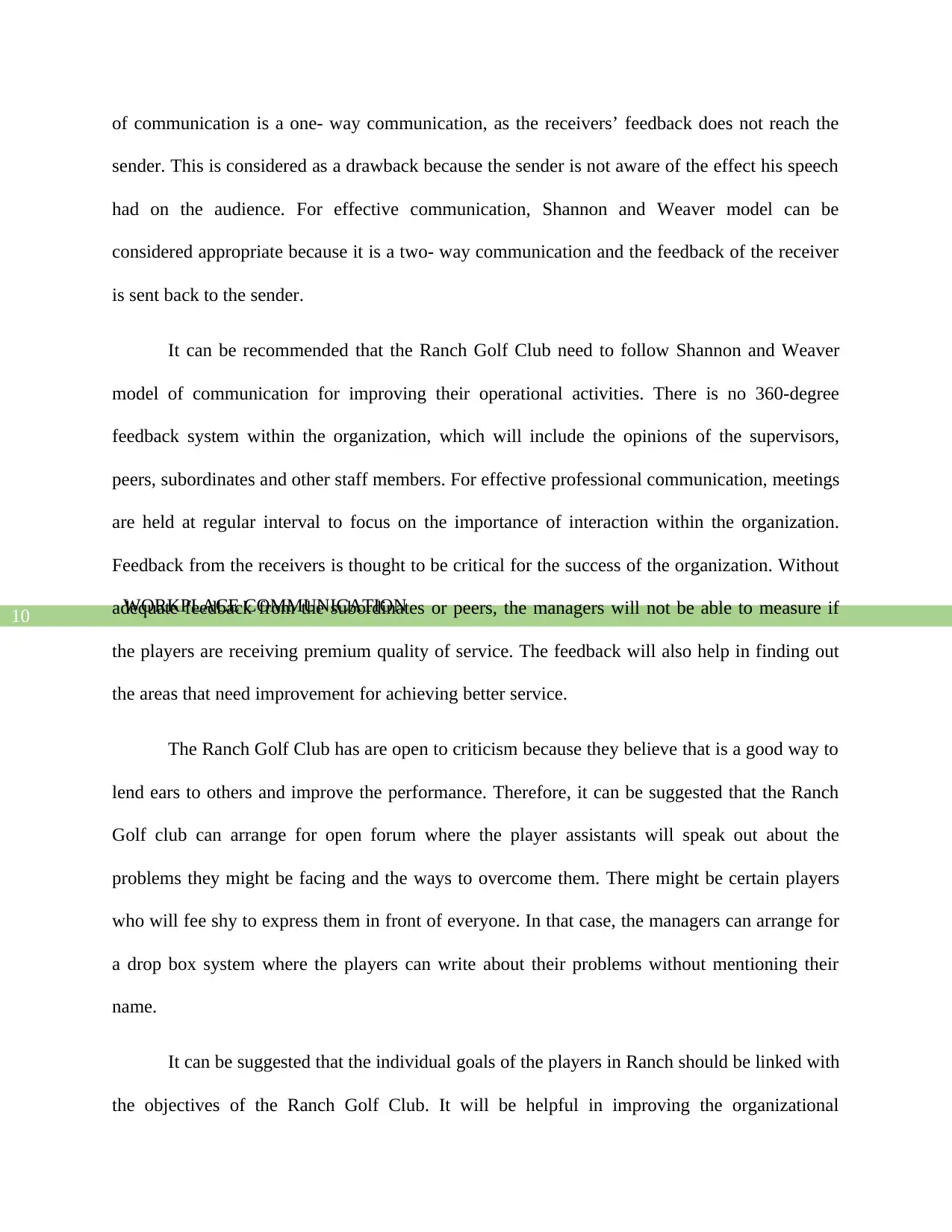
WORKPLACE COMMUNICATION
10
of communication is a one- way communication, as the receivers’ feedback does not reach the
sender. This is considered as a drawback because the sender is not aware of the effect his speech
had on the audience. For effective communication, Shannon and Weaver model can be
considered appropriate because it is a two- way communication and the feedback of the receiver
is sent back to the sender.
It can be recommended that the Ranch Golf Club need to follow Shannon and Weaver
model of communication for improving their operational activities. There is no 360-degree
feedback system within the organization, which will include the opinions of the supervisors,
peers, subordinates and other staff members. For effective professional communication, meetings
are held at regular interval to focus on the importance of interaction within the organization.
Feedback from the receivers is thought to be critical for the success of the organization. Without
adequate feedback from the subordinates or peers, the managers will not be able to measure if
the players are receiving premium quality of service. The feedback will also help in finding out
the areas that need improvement for achieving better service.
The Ranch Golf Club has are open to criticism because they believe that is a good way to
lend ears to others and improve the performance. Therefore, it can be suggested that the Ranch
Golf club can arrange for open forum where the player assistants will speak out about the
problems they might be facing and the ways to overcome them. There might be certain players
who will fee shy to express them in front of everyone. In that case, the managers can arrange for
a drop box system where the players can write about their problems without mentioning their
name.
It can be suggested that the individual goals of the players in Ranch should be linked with
the objectives of the Ranch Golf Club. It will be helpful in improving the organizational
10
of communication is a one- way communication, as the receivers’ feedback does not reach the
sender. This is considered as a drawback because the sender is not aware of the effect his speech
had on the audience. For effective communication, Shannon and Weaver model can be
considered appropriate because it is a two- way communication and the feedback of the receiver
is sent back to the sender.
It can be recommended that the Ranch Golf Club need to follow Shannon and Weaver
model of communication for improving their operational activities. There is no 360-degree
feedback system within the organization, which will include the opinions of the supervisors,
peers, subordinates and other staff members. For effective professional communication, meetings
are held at regular interval to focus on the importance of interaction within the organization.
Feedback from the receivers is thought to be critical for the success of the organization. Without
adequate feedback from the subordinates or peers, the managers will not be able to measure if
the players are receiving premium quality of service. The feedback will also help in finding out
the areas that need improvement for achieving better service.
The Ranch Golf Club has are open to criticism because they believe that is a good way to
lend ears to others and improve the performance. Therefore, it can be suggested that the Ranch
Golf club can arrange for open forum where the player assistants will speak out about the
problems they might be facing and the ways to overcome them. There might be certain players
who will fee shy to express them in front of everyone. In that case, the managers can arrange for
a drop box system where the players can write about their problems without mentioning their
name.
It can be suggested that the individual goals of the players in Ranch should be linked with
the objectives of the Ranch Golf Club. It will be helpful in improving the organizational
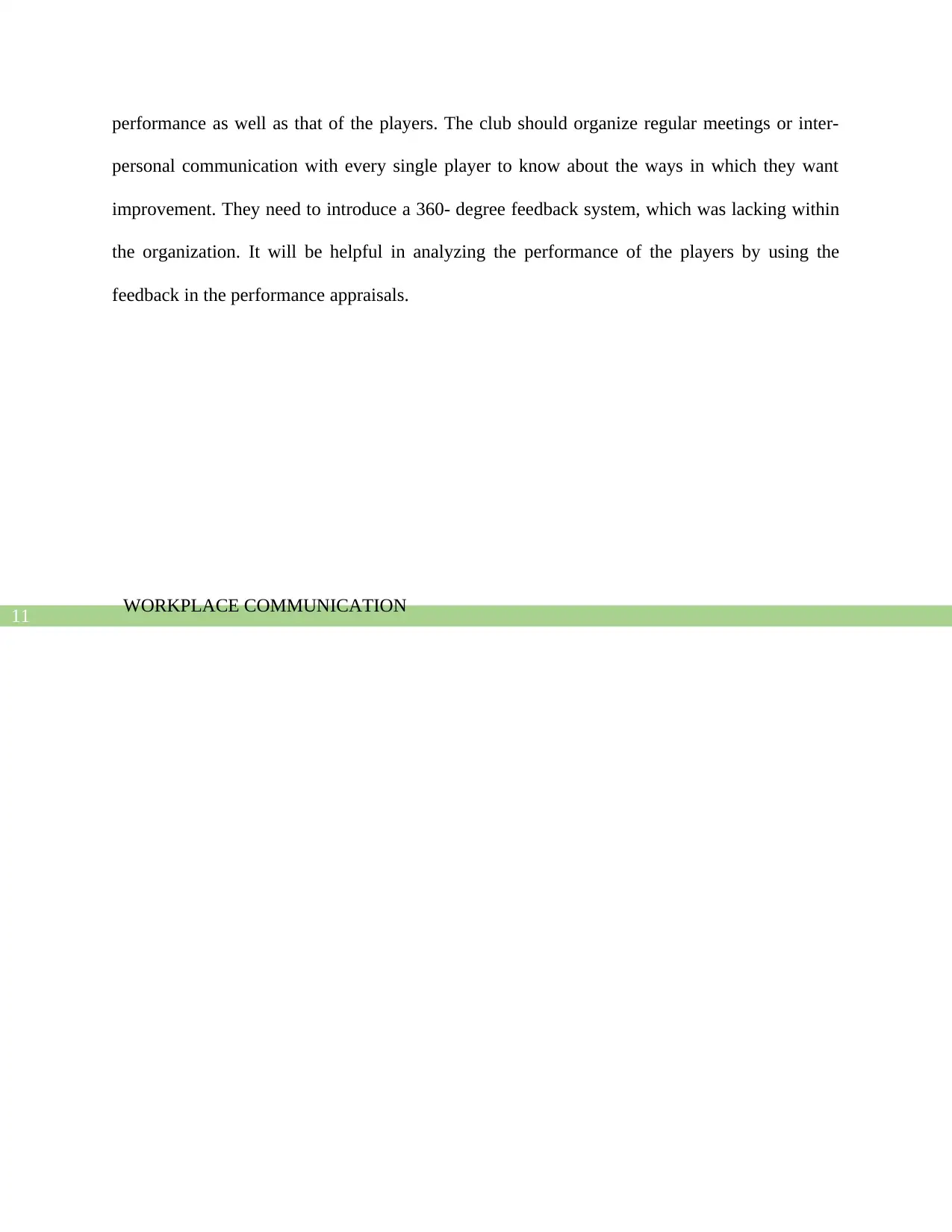
WORKPLACE COMMUNICATION
11
performance as well as that of the players. The club should organize regular meetings or inter-
personal communication with every single player to know about the ways in which they want
improvement. They need to introduce a 360- degree feedback system, which was lacking within
the organization. It will be helpful in analyzing the performance of the players by using the
feedback in the performance appraisals.
11
performance as well as that of the players. The club should organize regular meetings or inter-
personal communication with every single player to know about the ways in which they want
improvement. They need to introduce a 360- degree feedback system, which was lacking within
the organization. It will be helpful in analyzing the performance of the players by using the
feedback in the performance appraisals.
⊘ This is a preview!⊘
Do you want full access?
Subscribe today to unlock all pages.

Trusted by 1+ million students worldwide
1 out of 15
Related Documents
Your All-in-One AI-Powered Toolkit for Academic Success.
+13062052269
info@desklib.com
Available 24*7 on WhatsApp / Email
![[object Object]](/_next/static/media/star-bottom.7253800d.svg)
Unlock your academic potential
Copyright © 2020–2025 A2Z Services. All Rights Reserved. Developed and managed by ZUCOL.




